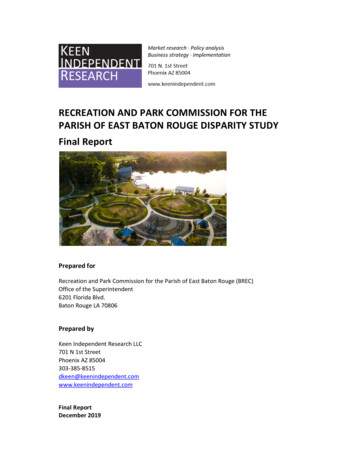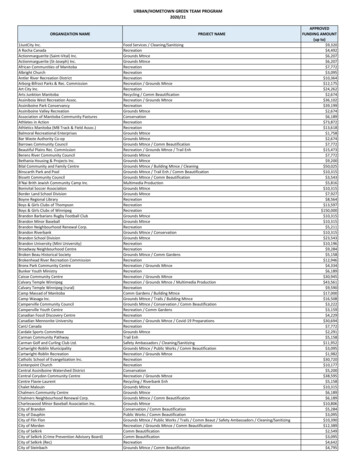
Transcription
RECREATION AND PARK COMMISSION FOR THEPARISH OF EAST BATON ROUGE DISPARITY STUDYFinal ReportPrepared forRecreation and Park Commission for the Parish of East Baton Rouge (BREC)Office of the Superintendent6201 Florida Blvd.Baton Rouge LA 70806Prepared byKeen Independent Research LLC701 N 1st StreetPhoenix AZ independent.comFinal ReportDecember 2019
TABLE OF CONTENTSEXECUTIVE SUMMARY. 2019 RECREATION AND PARK COMMISSION FOR THEPARISH OF EAST BATON ROUGE (BREC) DISPARITY STUDY1.BREC contract dollars primarily go to construction, goods, professional services and otherservices firms in the Baton Rouge metro area . ES-12.The Baton Rouge metro area marketplace is largely comprised of small businesses . ES-23.More than 40 percent of the local firms available for City construction, goods,professional services and other services contracts are owned by people of color or women . ES-24.The disparity study examined veteran- and service-disabled veteran-owned businesses . ES-25.There is not a level playing field for companies owned by people of color or for women inthe Baton Rouge metropolitan area . ES-26.BREC utilization of minority- and women-owned firms is less than what might be expectedbased on their availability . ES-27.The disparities in BREC utilization are not surprising given the low-bidpurchasing environment . ES-48.Disparities for minority- and women-owned firms in BREC contracts werefound even with BREC outreach efforts. ES-49.Without additional action, BREC will miss an opportunity to encouragegrowth and development of Baton Rouge metropolitan area small businesses . ES-4Recommendations . ES-5Public Comment Process for the Draft Disparity Study Report . ES-6CHAPTER 1. INTRODUCTIONA. What is a Disparity Study? . 1-1B.Why Conduct a Disparity Study?. 1-2C.Introduction to the Study Team. 1-3D. Involvement of Businesses, Trade Associations and Other Groups in the Study . 1-3E.Analyses Performed in the Disparity Study and Location of Results . 1-4F.Public Comment Process for the Draft Disparity Study Report . 1-5KEEN INDEPENDENT RESEARCH— 2019 BREC DISPARITY STUDYTABLE OF CONTENTS , PAGE i
CHAPTER 2. LEGAL ISSUES REGARDING BUSINESS ASSISTANCE PROGRAMA. Potential Legal Challenges to Government Programs to Assist Minority- andWomen-owned Firms . 2-1B.Legal Issues Concerning VOB, SDVOB or SBE Programs . 2-4C.Further Information . 2-4CHAPTER 3. BREC CONTRACTSA. Overview of BREC Contracts . 3-1B.Collection and Analysis of BREC Contract Data. 3-2C.Types of Work Involved in BREC Contracts . 3-3D. Location of Businesses Receiving BREC Contracts . 3-6CHAPTER 4. MARKETPLACE CONDITIONS IN THE BATON ROUGE METROPOLITAN AREAA. Composition of the Baton Rouge Metro Area Workforce and Business Owners . 4-2B.Entry and Advancement within Study Industries. 4-5C.Business Ownership . 4-7D. Access to Capital, Bonding and Insurance . 4-8E.Success of Businesses . 4-12F.Veterans and Service-Disabled Veteran Businesses . 4-18G. All Small Businesses . 4-19H. Conclusions Concerning the Baton Rouge Metropolitan Area Marketplace . 4-19CHAPTER 5. UTILIZATION AND DISPARITY ANALYSISA. Overview of the Utilization Analysis . 5-1B.Utilization of MBE/WBEs and VOB/SDVOBs in BREC Contracts . 5-2C.Disparity Analysis for BREC Contracts . 5-3D. Results by Industry. 5-7E.Results for Construction Prime Contracts and Subcontracts . 5-14F.Results by Size of Procurement . 5-16G. Statistical Significance of Disparity Analysis Results . 5-17KEEN INDEPENDENT RESEARCH— 2019 BREC DISPARITY STUDYTABLE OF CONTENTS , PAGE ii
CHAPTER 6. CONCLUSIONS AND ACTIONS FOR BREC CONSIDERATIONA. Conclusions . 6-1B.Recommendation: Adopt measures that can increase participation of socially andeconomically disadvantaged small businesses in BREC contracts . 6-3C.New BREC Targeted Business Program . 6-4D. Recommendation: Regional Training, Working Capital and Bonding Programs . 6-8APPENDIX A. DEFINITION OF TERMS . A-1APPENDIX B. LEGAL FRAMEWORK AND ANALYSISA. Introduction .B-1B.U.S. Supreme Court Cases .B-2C.The Legal Framework Applied to State and Local Government MBE/WBE/DBE Programs .B-4D. Recent Decisions Involving State or Local Government MBE/WBE/DBE Programsin Other Jurisdictions .B-38E.Recent Decisions Involving the Federal DBE Program and its Implementationby State and Local Governments in Other Jurisdictions .B-116F.Recent Decisions and Authorities Involving Federal Procurement That May ImpactDBE and MBE/WBE Programs .B-206APPENDIX C. UTILIZATION DATA COLLECTIONA. Data for Prime Contractors, Consultants and other Vendors .C-1B.Subcontract Data .C-2C.Characteristics of Utilized Firms .C-3APPENDIX D. GENERAL APPROACH TO AVAILABILITY ANALYSISGeneral Approach to Collecting Availability Information . D-1Development of the Survey Instruments . D-8Execution of Surveys . D-10MBE/WBE Availability Calculations on a Contract-by-Contract Basis . D-12Additional Considerations Related to Measuring Availability. D-14Availability Survey Instrument Fax Survey (Construction Version) . D-18KEEN INDEPENDENT RESEARCH— 2019 BREC DISPARITY STUDYTABLE OF CONTENTS , PAGE iii
APPENDIX E. ENTRY AND ADVANCEMENT IN THE BATON ROUGE CONSTRUCTION,PROFESSIONAL SERVICES, GOODS AND OTHER SERVICES INDUSTRIESIntroduction . E-1Construction Industry . E-5Professional Services Industry . E-17Goods Industry . E-20Other Services Industry . E-22Summary . E-24APPENDIX F. BUSINESS OWNERSHIP IN THE BATON ROUGE CONSTRUCTION, PROFESSIONAL SERVICES,GOODS AND OTHER SERVICES INDUSTRIESBusiness Ownership Rates . F-1Business Ownership Regression Analysis . F-7Summary of Business Ownership in the Baton Rouge Metropolitan Statistical Area. F-14APPENDIX G. ACCESS TO CAPITAL FOR BUSINESS FORMATION AND SUCCESS IN BATON ROUGEStart-up Capital . G-2Business Credit . G-5Homeownership and Mortgage Lending . G-12Summary . G-26APPENDIX H. SUCCESS OF BUSINESSES IN CONSTRUCTION, PROFESSIONAL SERVICES, GOODS ANDOTHER SERVICES INDUSTRIES IN BATON ROUGEBusiness Closures, Expansions and Contractions . H-1Business Receipts and Earnings . H-12Relative Bid Capacity . H-31Availability Interview Results Concerning Potential Barriers . H-34Summary . H-47KEEN INDEPENDENT RESEARCH— 2019 BREC DISPARITY STUDYTABLE OF CONTENTS , PAGE iv
APPENDIX I. DESCRIPTION OF DATA SOURCES FOR MARKETPLACE ANALYSESU.S. Census Bureau PUMS Data . I-1Survey of Small Business Finances (SSBF) . I-7Survey of Business Owners (SBO) . I-9Annual Survey of Entrepreneurs (ASE) Data . I-10Home Mortgage Disclosure Act (HMDA) Data . I-11APPENDIX J. QUALITATIVE INFORMATION FROM IN-DEPTH INTERVIEWS, AVAILABILITY SURVEY,TOWN HALLS AND OTHER PUBLIC COMMENTSA. Introduction and Methodology . J-1B.Background on the Firm and Industry . J-2C.Keys to Business Success. J-16D. Prime-subcontractor Relationships . J-23E.Working on Projects with the City-Parish and BREC . J-29F.Whether There is a Level Playing Field in the Baton Rouge Marketplace . J-41G. Insights Regarding Contract Goals, Business Assistance Programs and Certification. J-59H. Any Other Insights and Recommendations for the City-Parish and BREC . J-66APPENDIX K. BUSINESS ASSISTANCE PROGRAMSA. Federal Programs . K-1B.State and Local Government, Not-for-Profit and Private Sector Programs . K-4APPENDIX L. ANALYSIS OF OTHER CONSTRUCTION PROJECTSA. Compilation of Data for Similar Construction Projects in the Baton Rouge Area . L-1B.Dollar-Weighted Availability Results. L-2C.Utilization and Disparity Analysis . L-4KEEN INDEPENDENT RESEARCH— 2019 BREC DISPARITY STUDYTABLE OF CONTENTS , PAGE v
EXECUTIVE SUMMARY.2019 Recreation and Park Commission for theParish of East Baton Rouge (BREC) Disparity StudyThe Recreation and Park Commission for the Parish of East Baton Rouge (BREC) seeks to ensureequity in its contracting activities. It commissioned a disparity study to determine if there is a levelplaying field for minority- and women-owned firms when competing for BREC contracts andsubcontracts.This disparity study examines whether there are any barriers to minority- and women-owned firmsseeking work with BREC, and if so, actions to be taken. It also helps BREC and others inBaton Rouge identify the types of assistance minority- and women-owned companies might need tofully participate in the local economy. In addition, the disparity study examines participation ofveteran- and service-disabled veteran-owned businesses in BREC contracts and in the overallmarketplace.BREC retained Keen Independent Research LLC (Keen Independent) to perform the disparitystudy. Subconsultants participating in the study included Baton Rouge firms Octagon Media andSimmons J. Barry (SJB) Group; Spears Group from New Orleans; the telephone survey firmCustomer Research International (CRI) and the national law firm Holland & Knight. Octagon Media,SJB Group and Spears Group performed in-depth interviews with Baton Rouge area businessowners and trade association representatives. CRI performed telephone interviews with thousands oflocal businesses.Keen Independent performed a parallel disparity study for the City of Baton Rouge, Parish ofEast Baton Rouge (City-Parish). Marketplace information from each study was shared.Based on this research, BREC can remove barriers and develop new targeted business programs incollaboration with other public, private and nonprofit groups in the Baton Rouge area. TheKeen Independent study team developed key conclusions and recommendations for BRECconsideration. These conclusions and recommendations are summarized below and further discussedin Chapter 6 of this report.1. BREC contract dollars primarily go to construction, goods, professional services and otherservices firms in the Baton Rouge metro area.BREC contract dollars primarily go to construction, goods, professional services and other servicesfirms with locations in the Baton Rouge metropolitan area. BREC spending has the potential topositively affect the local economy, growing local businesses and adding to local jobs.KEEN INDEPENDENT RESEARCH— 2019 BREC DISPARITY STUDYEXECUTIVE SUMMARY , PAGE 1
2. The Baton Rouge metro area marketplace is largely comprised of small businesses.More than 90 percent of businesses in the Baton Rouge metropolitan area that are available forBREC construction, goods, professional services and other services contracts are small businesses.The health of those small businesses is critical to the local economy.3. More than 40 percent of the local firms available for City construction, goods, professionalservices and other services contracts are owned by people of color or women.About 41 percent of the local firms available for BREC construction, goods, professional servicesand other services contracts are owned by people of color or women. The local economy cannot behealthy if these firms are left behind.4. The disparity study examined veteran- and service-disabled veteran-owned businesses.About 9 percent of businesses in the construction, professional services, goods and other servicesindustries are veteran-owned, including service-disabled veterans.5. There is not a level playing field for companies owned by people of color or for women inthe Baton Rouge metropolitan area.Minority- and women-owned firms are underutilized in the local marketplace as a whole. Minorityand women-owned firms are more likely to be small, experience difficulties obtaining financing andbonding, and face other roadblocks. Many minority- and women-owned firms are socially andeconomically disadvantaged when competing for work, including public sector contracts.As an example of the disparities in the Baton Rouge area marketplace, Keen Independent comparedthe utilization and availability of minority- and women-owned firms (MBE/WBEs) for private andother public sector construction contracts. There was substantially less participation of MBE/WBEconstruction contractors and design firms than what would be expected from the relative availabilityof local minority- and women- companies to perform that work.6. BREC utilization of minority- and women-owned firms is less than what might be expectedbased on their availability.About 21 percent of BREC contract dollars from 2014 through 2018 went to minority- andwomen-owned firms. This is relatively high for a public agency that does not have an MBE/WBEprogram. About 27 percent of BREC contracts dollars went to small businesses, and 4 percent wentto veteran-owned businesses, including service-disabled veterans. The share of contract dollars goingto MBE/WBEs, VOBs and small businesses was greater for BREC than identified in the disparitystudy for the City-Parish.Even with the observed levels of MBE/WBE, VOB and small business participation, there were stilldisparities between the utilization and availability of those groups in BREC contracts.Keen Independent analyzed 801 BREC contracts and subcontracts totaling 24.8 million awardedfrom January 2014 through December 2018. Keen Independent determined the dollars going tominority- and women-owned firms, veteran- and service-disabled veteran firms (VOBs andKEEN INDEPENDENT RESEARCH— 2019 BREC DISPARITY STUDYEXECUTIVE SUMMARY , PAGE 2
SDVOBs) as well as other businesses. Keen Independent then calculated MBE/WBE andVOB/SDVOB utilization by dividing the dollars going to those firms by total contracts dollars.Keen Independent compared the actual utilization of MBE/WBEs, VOBs and SDVOBs on BRECcontracts with the percentage of contract dollars that those groups might be expected to receivebased on their availability for that work (availability is also referred to as the “utilizationbenchmark”). Keen Independent made those comparisons for individual MBE/WBE groups.Figure ES-1 presents these overall results from the disparity analysis. There were substantialdisparities for MBE/WBEs, VOBs, SDVOBs and small businesses.Minority- and women-owned firms. The utilization of minority- and women-owned firms in BRECcontracts during the study period — about 21 percent of total contract dollars — was below the33 percent that might be expected from the availability analysis. (The 33% availability benchmark isless than 41% because it takes into account the types and sizes of work that different firms bid on.)Veteran-owned businesses. Utilization of veteran-owned businesses (4% of contract dollars) wasalso below availability of VOBs for this work (9%). Within these totals for VOBs, the utilization andavailability of service-disabled veteran-owned firms for BREC contracts were about 1 percent.Small businesses. Small businesses received 27 percent of BREC contract dollars examined in thestudy.Figure ES-1.Disparity analysis for BREC contracts, 2014–2018Source:Keen Independent utilization and availability analyses for BREC contracts.KEEN INDEPENDENT RESEARCH— 2019 BREC DISPARITY STUDYEXECUTIVE SUMMARY , PAGE 3
7. The disparities in BREC utilization are not surprising given the low-bid purchasingenvironment.The disparities in BREC utilization are not surprising given the low-bid purchasing environment fora large share of its contract dollars, which is required under state law for most purchases of a certainsize. Barriers to small businesses in general, and minority- and women-owned firms in particular,make it difficult for local small businesses to compete with the largest companies on price.In some instances, small businesses cannot meet the requirements to be able to bid at all, such asobtaining necessary bonding and insurance or meeting other qualifications requirements. They mightnot have the working capital to afford to perform public sector work. Some small businesses,including those owned by people of color and women, have become discouraged from competingfor public sector contracts and subcontracts.8. Disparities for minority- and women-owned firms in BREC contracts were found even withBREC outreach efforts.The disparities for minority- and women-owned firms in BREC contracts were found even withBREC efforts to encourage small business and MBE/WBEs participation in its contracts. To date,the primary tools available to BREC have been outreach and inclusion of MBE/WBE bidders forsmaller goods and services purchases. At present, BREC staff lack tools to do more.9. Without additional action, BREC will miss an opportunity to encourage growth anddevelopment of Baton Rouge metropolitan area small businesses.BREC has an opportunity to encourage growth and development of Baton Rouge metropolitan areasmall businesses through greater assistance to those firms and by encouraging participation in itscontracts, especially for minority- and women-owned firms.BREC has an opportunity to expand its pool of firms capable of competing for its contracts andsubcontracts over the long-term, which can lower procurement costs.And, without additional action, BREC is at risk of being linked to a marketplace that perpetuatesunequal outcomes for minority- and women-owned firms.KEEN INDEPENDENT RESEARCH— 2019 BREC DISPARITY STUDYEXECUTIVE SUMMARY , PAGE 4
RecommendationsKeen Independent recommends that BREC adopt measures that can increase participation ofsocially and economically disadvantaged small businesses in BREC contracts.These initiatives should be two-pronged: (1) leveling the playing field for local small disadvantagedbusinesses in BREC contracts and subcontracts, and (2) participating with other public, private andnonprofit partners in the region to enhance the ability of local disadvantaged businesses to access tocapital and bonding and gain necessary experience.Some of the ways to level the playing field will require action by the BREC Commission. This shouldinclude a subcontract goals program and the ability to reserve certain small contracts for bidding onlyfrom disadvantaged businesses.New efforts will require a system designed to reach out to disadvantaged firms and help themwith public procurement and programs. This effort will require a system to reach out todisadvantaged firms, help them with public procurement and to certify them to make sure thebenefits of the programs go to firms that are socially and economically disadvantaged.Business owners from various backgrounds can be socially disadvantaged. Certification as a localdisadvantaged business would be open to business owners regardless of their race, ethnicity orgender if they demonstrate social and economic disadvantage. And veterans, especiallyservice-disabled veterans, should be encouraged to apply for program certifications.BREC will need to create a disadvantaged business program, including certification rules andthe tools to encourage participation. BREC is not alone in attempting to build its small businesses,including minority- and women-owned businesses. Atlanta, Houston and New Orleans have createdprograms to assist disadvantaged businesses in their communities that provide examples of what canbe done in Baton Rouge. This can speed implementation of efforts in Baton Rouge.A disadvantaged business program requires financial resources from BREC. This effort willrequire financial resources from BREC to participate in a regional certification program for localsocially and economically disadvantaged businesses. It will also require investments in staff time andtechnology for program compliance and perhaps financial contribution to a regional partnership toprovide financing and bonding for disadvantaged businesses.A disadvantaged business program requires long-term commitment from BREC. To besuccessful, BREC must make a multi-year commitment to address barriers to disadvantaged businessparticipation. BREC will need to develop short-, medium- and long-term objectives to be met thatcan show progress in remedying disadvantages and building capacity and opportunities for the localsmall business community.Over time, this effort can increase participation of socially and economically disadvantagedbusinesses in BREC contracts to what would be expected based on the potential of those businesses.BREC and its partners can enhance the health of the local small business community.KEEN INDEPENDENT RESEARCH— 2019 BREC DISPARITY STUDYEXECUTIVE SUMMARY , PAGE 5
Public Comment Process for the Draft Disparity Study ReportKeen Independent and BREC published a draft report for public comment in November 2019before finalizing the report.The public was also able to give feedback and provide written comments: In person at the Town Halls; Online at y; Via email at batonrougedisparitystudy@keenindependent.com; and Through regular mail to Keen Independent Research LLC; 701 N. 1st St., 2nd Floor,Phoenix, AZ 85004.Keen Independent reviewed information from the Town Halls and written comments beforeincorporating them into the final Disparity Study report.KEEN INDEPENDENT RESEARCH— 2019 BREC DISPARITY STUDYEXECUTIVE SUMMARY , PAGE 6
CHAPTER 1.IntroductionThe Recreation and Park Commission for the Parish of East Baton Rouge (BREC) seeks to ensureequity in its contracting activities. It commissioned a disparity study to determine if there is a levelplaying field for minority- and women-owned firms when competing for BREC contracts andsubcontracts. This research examines whether there are any barriers to minority- and women-ownedfirms seeking work with BREC, and if so, actions to be taken. It also helps BREC and others inBaton Rouge identify the types of assistance minority- and women-owned companies might need tofully participate in the local economy.In addition, the disparity study examines participation of veteran- and service-disabledveteran-owned businesses in BREC contracts and in the overall marketplace. The study researchedsmall business utilization as well. This study collectively refers to minority-, women-, veteran- andservice-disabled veteran-owned businesses, as well as small businesses in general, as “targetedbusinesses.” Programs to assist such businesses are titled “targeted business programs.”Based on this research, BREC can
study. Subconsultants participating in the study included Baton Rouge firms Octagon Media and Simmons J. Barry (SJB) Group ; Spears Group from New Orleans; the telephone survey firm Customer Research International (CRI) and the national law firm Holland & Knight. Octagon Media,











